
Spiny lizards is a common name for the genus Sceloporus in the family Phrynosomatidae. The genus is endemic to North America, with various species ranging from New York, to Washington, and one occurring as far south as northern Panama. The greatest diversity is found in Mexico. This genus includes some of the most commonly seen lizards in the United States. Other common names for lizards in this genus include fence lizards, scaly lizards, bunchgrass lizards, and swifts.

Echinosaura is a genus of lizards, called commonly the spined tegus, in the family Gymnophthalmidae. The genus is endemic to Central America and South America.
The Key tegu is a species of lizard in the family Gymnophthalmidae. The species is endemic to Ecuador.

Tropidoclonion is a genus of snake in the subfamily Natricinae of the family Colubridae. The genus is monotypic, containing the sole species Tropidoclonion lineatum, commonly known as the lined snake. The species is endemic to North America.

The long-nosed snake is a species of nonvenomous snake in the family Colubridae. The species is endemic to North America. It has two recognized subspecies. The other species in the genus were previously considered subspecies.

Tantilla is a large genus of harmless New World snakes in the family Colubridae. The genus includes 66 species, which are commonly known as centipede snakes, black-headed snakes, and flathead snakes.

Ficimia is a genus of colubrid snakes commonly known as hooknose snakes or hook-nosed snakes, which are endemic to North America. There are seven species within the genus.
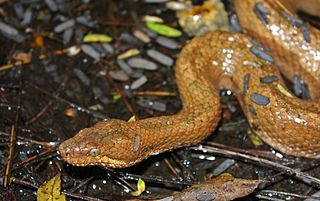
Tropidophis, common name Caribbean dwarf boas, wood snakes or West Indian wood snakes, is a genus of dwarf boas endemic to the West Indies and South America. Currently, either 17 or 33 species are recognized, depending on the authority.

Stenocercus is a genus of South American lizards, commonly called whorltail iguanas, of the family Tropiduridae. This genus has 80 valid described species.
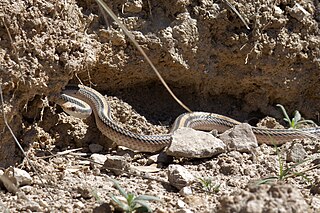
Salvadora hexalepis, the western patch-nosed snake, is a species of non-venomous colubrid snake, which is endemic to the southwestern United States and northern Mexico.

Geophis is a genus of snakes in the subfamily Dipsadinae of the family Colubridae of the superfamily Colubroidea. Species in the genus Geophis are commonly referred to as Latin American earth snakes. The genus consists of 53 distinct species.
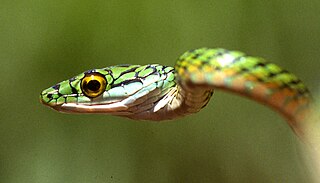
Leptophis is a genus of colubrid snakes, commonly known as parrot snakes. The species within this genus are widely distributed throughout Mexico, Central and South America.
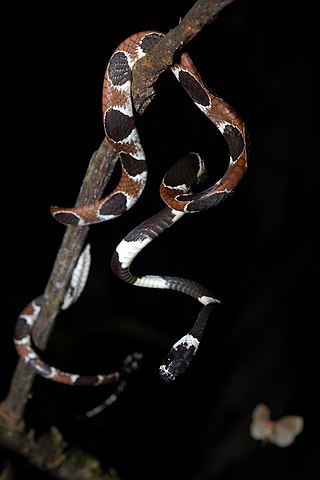
Dipsas is a genus of nonvenomous New World snakes in the subfamily Dipsadinae of the family Colubridae. The genus Sibynomorphus has been moved here. Species of the genus Dipsas are known as snail-eaters.

Imantodes is a genus of colubrid snakes commonly referred to as blunt-headed vine snakes or blunt-headed tree snakes. The genus consists of seven species that are native to Mexico, Central America, and the northern part of South America.
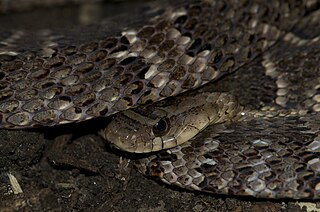
Xenodon rabdocephalus, commonly known as the false fer-de-lance, is a species of mildly venomous rear-fanged snake in the family Colubridae. The species is native to Central America and northern South America. There are two recognized subspecies.

Tropidodipsas is a genus of New World snakes of the family Colubridae.

Synophis calamitus, the calamitous shadow snake, is a species of snake in the family Colubridae. The species is endemic to northwestern South America.
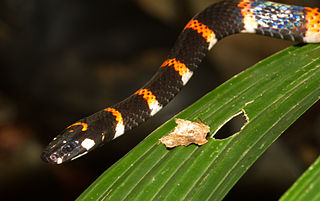
Pliocercus euryzonus, commonly known as Cope's false coral snake, is a species of snake in the subfamily Dipsadinae of the family Colubridae. The species is indigenous to southeastern Central America and northwestern South America. There are two recognized subspecies.
Emmochliophis fugleri, also known commonly as Fugler's shadow snake, the Pichincha snake, and the Pinchinda snake, is a species of snake in the family Colubridae. The species is endemic to Ecuador.
Emmochliophis miops is a species of snake of the family Colubridae. The species is found in Ecuador and Colombia.
















